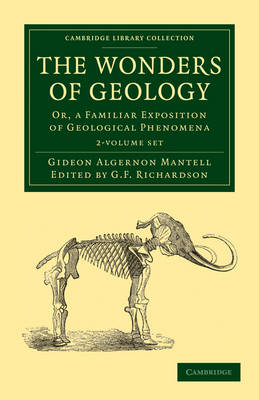Cambridge Library Collection - Earth Science
1 primary work • 5 total works
Volume 2
Gideon Mantell (1790–1852) was an English physician and geologist best known for pioneering the scientific study of dinosaurs. After an apprenticeship to a local surgeon in Sussex, Mantell became a member of the Royal College of Surgeons in 1811. He developed an interest in fossils, and in 1822 his discovery of fossil teeth which he later identified as belonging to an iguana-like creature he named Iguanadon spurred research into ancient reptiles. These volumes, first published in 1838, contain a series of eight lectures which describe and explain early principles of geology, stratification and fossil plants and animals to a non-scientific audience. These detailed volumes became Mantell's most popular work, and provide a fascinating view of the study of geology and palaeontology during the early nineteenth century. Volume 2 contains lectures 5–8, discussing marine fossils including animals and corals, fossil plants and volcanic rocks.
Gideon Mantell (1790–1852) was an English physician and geologist best known for pioneering the scientific study of dinosaurs. After an apprenticeship to a local surgeon in Sussex, Mantell became a member of the Royal College of Surgeons in 1811. He developed an interest in fossils, and in 1822 his discovery of fossil teeth which he later identified as belonging to an iguana-like creature he named Iguanadon spurred research into ancient fossils. This volume, first published in 1822, contains Mantell's early research into fossil remains of southern England. Arranged according to rock type and strata, Mantell provides descriptions and analysis of fossil tropical plants, fish, molluscs and what he described as 'an animal of the lizard tribe, of enormous magnitude'. This volume was the first published work to describe a collection of dinosaur remains and provides a fascinating view of early palaeontological research before the formation of the discipline.
Gideon Mantell (1790–1852) was an English physician and geologist best known for pioneering the scientific study of dinosaurs. After an apprenticeship to a local surgeon in Sussex, Mantell became a member of the Royal College of Surgeons in 1811. He developed an interest in fossils, and in 1822 his discovery of fossil teeth which he later identified as belonging to an iguana-like creature he named Iguanadon spurred research into ancient fossils. This volume, first published in 1833, contains the results of Mantell's research into the geology and fossil remains of south-eastern England, especially Sussex and Kent. Mantell describes each rock stratum of the region in detail, and includes within each section descriptions of fossil remains found in the formation, arranged by species. Copiously illustrated, this volume remains one of Mantell's best known works and contains fascinating detail concerning the development of geology and palaeontology.
Gideon Mantell (1790-1852) was an English physician and geologist best known for pioneering the scientific study of dinosaurs. After an apprenticeship to a local surgeon in Sussex, Mantell became a member of the Royal College of Surgeons in 1811. He developed an interest in fossils, and in 1822 his discovery of fossil teeth which he later identified as belonging to an iguana-like creature he named Iguanadon spurred research into ancient reptiles. These volumes, first published in 1838, contain a series of eight lectures which describe and explain early principles of geology, stratification and fossil plants and animals to a non-scientific audience. These detailed volumes became Mantell's most popular work, and provide a fascinating view of the study of geology and palaeontology during the early nineteenth century.
Gideon Mantell (1790–1852) was an English physician and geologist best known for pioneering the scientific study of dinosaurs. After an apprenticeship to a local surgeon in Sussex, Mantell became a member of the Royal College of Surgeons in 1811. He developed an interest in fossils, and in 1822 his discovery of fossil teeth which he later identified as belonging to an iguana-like creature he named Iguanadon spurred research into ancient reptiles. These volumes, first published in 1838, contain a series of eight lectures which describe and explain early principles of geology, stratification and fossil plants and animals to a non-scientific audience. These detailed volumes became Mantell's most popular work, and provide a fascinating view of the study of geology and palaeontology during the early nineteenth century. Volume 1 contains lectures 1–4, discussing the formation and composition of rock strata, chalk formations and fossil animals.

